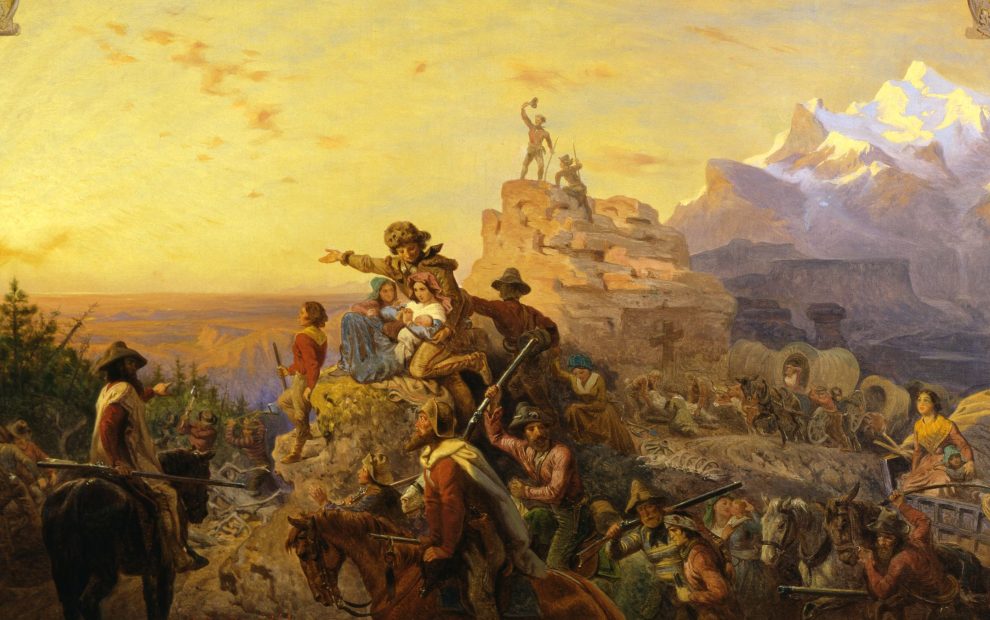Many of us have heard the saying that “slavery is America’s original sin.” Robert P. Jones, president and founder of the Public Religion Research Institute (PRRI) doesn’t necessarily disagree with this sentiment, but it doesn’t go back far enough, in his opinion, to really help us understand how deeply engrained white supremacy is in our nation.

Instead, Jones says, we should look back to 1493, the year after Columbus sailed the ocean blue with his three ships. This was the year Columbus returned to Spain, asking for more resources and the blessing of the crown to colonize this “new” land. It was also the year that solidified the “doctrine of discovery,” papal pronouncements justifying European colonization and genocide of Indigenous people around the world.
The enslavement of Africans is not America’s original sin, then, but rather the continuation of a genocide that started with the first European contact with North Americans. In his new book, The Hidden Roots of White Supremacy (Simon & Schuster), Jones says he “tries to hold together two strands of history we often silo—African American history and Indigenous American history—and the relationship of Europeans to both of these histories.”
For Jones, the purpose of telling these stories is to confront white Americans’ complicity in racial violence and work toward reparations and restitution. He hopes that an unflinching look at white Americans’ participation in racial violence will encourage the creation of new American narratives—ones that don’t rely on a kind of white European exceptionalism or the idea that God created America as a promised land for white Europeans.
What is the doctrine of discovery?
The idea that the Americas are a kind of promised land for European Christians traces back to this set of documents—essentially a set of official doctrines, or papal bulls, from the mid- to late-15th century—that have become known as the “doctrine of discovery.”
Between 1452 and 1493, all these non-European lands were being “discovered,” and that created a political and theological dilemma for European powers. What were their responsibilities toward these people and lands they hadn’t even known existed? There was this crisis, because there was no way to make sense of it within the existing theological, cultural, or political map of the world at that time.
So political rulers appealed to the closest thing to international law that existed in the West: the Roman Catholic Church and the pope. And so popes began to issue these opinions in official papal bulls that spelled out a legal, moral, and religious framework for how to understand the European relationship to other peoples and lands.
You can read all these letters on doctrineofdiscovery.org, where they’re available in both Latin and English. But they essentially all boil down to one key idea: They all answered the question about what rights these people might have that Europeans were bound to respect. That answer about these people’s rights depended on whether they were Christian. And of course the answer to that was no. And thus, the documents went on to spell out that Europeans, under the authority of the church and the crowns, had the permission of the church and authority of the state to possess these lands, steal these people’s goods, and “reduce these persons to perpetual slavery.” The language was very, very clear about the assumed dominance and superiority of European Christians over other people.
Did these papal bulls mark a change in theology, or did they articulate already-existing beliefs?
It’s hard for us to fathom that these lands and peoples were literally not conceivable until Europeans all of a sudden “discovered” these entire continents they didn’t know were there with all these people living there. The doctrine of discovery was an attempt to fit this new information into their existing worldview in a way that made sense.
There were certainly political, economic, and religious motives for writing the papal bulls, and they all worked together so Europeans could reassure themselves that, yes, they were indeed God’s chosen superior people and, as such, had the rights to occupy the land, take the goods, and kill people if necessary.
What did the doctrine of discovery look like in practice? How did European nations lay claim to land?
It’s very clear in paintings. We’ve all seen these paintings of Columbus or de Soto or other conquistadors planting a flag on some piece of land. Often, in the background, there will be a cross that they’ve also planted there. These are symbols of both the state and the church.
In art, these symbols are not just symbolic or an artistic choice: They were part of actual rituals of conquest. They would plant a flag to claim political authority and put up a cross to claim religious authority.
Spanish explorers would read from this document called the Requerimiento, which was a Latin document basically staking their claim to these lands. They would often read it in front of the Indigenous people, who of course didn’t speak Latin or Spanish or French. But the acts of reading the document, planting the flag, and raising the cross conveyed ownership to Europeans through this ritual that was legal, moral, and religious.
Were there rules about how much land could be claimed at once?
It was pretty complicated, because obviously people weren’t literally surveying the land and marking it off in the way that we think about today. But there was a common understanding among European powers that if you claimed a river, you were also claiming all the lands into which the river drained and all the tributaries. So people would commonly try to get to rivers to stake a claim.
One reason the Louisiana Purchase territory, which the United States purchased from France, looks the way it does, for example, is that it includes the Mississippi River and all the lands and tributaries into which the river drains. It’s this huge swath of land that goes as far west as Oklahoma, all the way north to Minnesota, and all the way south to New Orleans. But of course at the time they had no idea how huge a claim they were making until they explored the whole thing.
Speaking of the Louisiana Purchase, we are often taught in school that it was this ingenious real estate deal—that President Thomas Jefferson managed to get the land at such a tiny price per acre. But I’ve come to understand that the land wasn’t occupied except by Indigenous people. France didn’t have forts set up on the land or anything like that. It was just this on-paper agreement among European powers about who had dominance over the Indigenous people. And so what Jefferson was purchasing was the right of domination, not the actual land.
Many people say that to understand white supremacy in this country, we have to go back to 1619, the year the first enslaved Africans arrived in the United States. But you argue that we have to go back further, to 1493.
The 1619 Project was this cultural watershed that positioned itself against this idea that the country began in 1776 with a bunch of white men in colonial finery in Philadelphia. It argues that, “Wait a minute. That’s not the origin story of our country. We have to back up and tell the story of enslaved Africans in the United States if we really want to understand the origin of the British colonies, how they developed, and how we ended up where we are.”
The 1619 Project totally changed how we think of American history. And it’s absolutely right. But if the 1619 Project takes a step back in history so that we see 1619 in the frame instead of taking a narrow view of 1776, I want to go just one step further. My reason is this: By 1619, there had already been more than a century of European interaction with Indigenous people on this continent. And so, if we are going to understand the full story—not only the importation, enslavement, and kidnapping of Africans into the colonies, but also the genocide, displacement, and treatment of Native American people—then we need to go back still further.
For me, that’s back to 1493, the year one of the most relevant papal bulls was penned. That year is familiar to people: It’s not 1492, the year Columbus sailed the ocean blue. It’s the year he came back to Spain and asked for more ships, more soldiers, and more priests. The year he asked for a moral mandate for the colonial project. That’s what he got in the papal bull.
Using really broad strokes, can you connect the dots from 1493 to 1619?
What’s really being established during this time is white supremacy and Christian domination. You’ve got about a 50-year period where the idea is given this official stamp by the church and by the pope, which then sets off the entire colonial project. And this leads to both the displacement and genocide of Indigenous people and the enslavement of Africans.
Take a place like Mississippi, which is where I’m from. You can’t really understand that place until you understand, first of all, Hernando de Soto arriving there (back when the only people living there were Indigenous people) and claiming that land for Spain. This set off a whole series of events that culminated in the Trail of Tears, where Native Americans were forcibly pushed off the land. And in the wake of that—kind of simultaneous to that, in fact—Africans were being enslaved and brought to clear the land and turn it into farmland. Most of the Mississippi Delta was a swampy forest. It wasn’t farmable. It had to be drained. It had to be cleared. This was backbreaking work that took a huge number of enslaved Africans to accomplish.
What about after the formation of the United States? Did the ideas of the doctrine of discovery continue on?
The doctrine of discovery is in our legal documents. It’s in our cultural tropes. We’ve all heard of manifest destiny: At the heart of that is this idea that European Christians are the ones who have the rights to the land from coast to coast.
It’s in the Declaration of Independence. People don’t read beyond the beginning very often, but it includes a list of the colonies’ grievances. Among these is the fact that the king of England will not let them colonize further. Basically, they want to take over the land the king had reserved for Indigenous Americans at the time. They also accuse the king of inciting slave rebellions in the colonies to sow social discord. And then, of course, the Constitution famously directly excludes Indians (the word it uses) from basic rights and counts Africans as three-fifths of a person—and even that’s only for empowering their enslavers. So the doctrine of discovery is embedded in our country’s most foundational documents.
It’s also embedded in Supreme Court cases. In 1823, Johnson v. McIntosh actually incorporates the doctrine of discovery into U.S. case law. This was a land dispute that dealt with the question of who had the right to issue land deeds to Indigenous people—could private individuals do so or did it have to be the federal government? The court basically decided that the federal government is the only one who can give deeds to Native Americans and, in their justification, straight up cites papal bulls and the doctrine of discovery. It essentially says that since Europeans have asserted these ideas and accepted them as the law of the land for all these years, they really can’t be questioned now.
The case establishes as precedent these rather absurd claims that just because white Americans show up, they can announce the land is theirs. They perform these little rituals of planting a cross and flag, and voilà, the land belongs to them.
That statement isn’t just relegated to the 19th century: It’s still cited. It was cited as recently as 2005 by none other than Ruth Bader Ginsburg. She cited this case as the very basis of property rights in the United States, and it goes directly back to the doctrine of discovery.
And then there’s the fact that we’re still fighting over the rise of white Christian nationalism in this country. That, at its core, is the claim that “this country belongs to we who are white European Christians. This is our land as decreed by God.” And that is nothing other than the core idea of the doctrine of discovery.
How else does the doctrine of discovery play into the narratives we tell about our nation?
I think it’s remarkable that you can still measure the doctrine of discovery, which is 500 years old, in public opinion surveys today. Public Religion Research Institute has found that 3 in 10 Americans affirm the central idea of the doctrine of discovery today, which is that God intended America to be a promised land for European Christians. That cultural idea still has such a hold on our country.
I grew up Southern Baptist and evangelical in Mississippi, where that was the dominant cultural and religious expression. There was this sense that everything we had, we deserved.
Most Native Americans had been pushed out of the state in the 1830s; there’s still a reservation of Choctaw people up in the northern part of the state, but in Jackson, where I lived, there was very little representation. I learned about Indigenous people as if they were almost Paleolithic, like they existed way back in ancient history. The genocide was left out. There was this kind of benign sense that we arrived and they left and now we just own everything.
But the violence existed. In 1834, Alexis de Tocqueville came to this country and wrote Democracy in America about what makes U.S. democracy and culture unique. He witnessed President Andrew Jackson’s Indian removal policies. He gives this heartbreaking account of how Indigenous people were pushed into boats in the middle of winter with very little clothing or provisions and forcibly shipped across the river from Mississippi to Oklahoma to make room for the European settlers to come in.
Part of what I’m trying to do is to make those stories present to white Americans today. To challenge these myths with which we’ve been brought up that justify our place in this nation and our sense of entitlement. There’s this idea that white European Christians are God’s chosen people and were given this land by God. When you say it out loud, you realize that’s a pretty audacious claim. It’s not really justifiable. But what does that mean for us today, if it’s not justifiable and yet it’s everything we’ve used to build and legitimize the status quo? That leaves us with some work to do.
What other ways does the doctrine of discovery show up in our everyday lives?
Today we see it most sharply in debates around immigration and the way some of our leading politicians talk about immigrants. Former President Donald Trump will say things over and over again like if we don’t vote for him and stem the tide of immigration, we won’t have a country anymore.
Who’s the we who won’t have a country? What kind of country won’t we have? It’s pretty clear that he’s evoking this kind of European Christian country. And more recently we’ve seen even harsher and more disturbing language about immigrants being vermin who are poisoning the blood of the country—this really troubling Nazi rhetoric. This again is evoking the supposed purity of white Christian America against the “impurities” of non-white or non-Christian people who might come into the country.
Today the fights we have in this country are less and less about policy. We’re not really disagreeing about whether health care should be delivered this way or that way. Instead we’re fighting over who we are as a country. Who is America?
It really comes down to this big question of whether we’re a pluralistic democracy where everybody stands on equal footing before the law regardless of race or religion or whether we are a kind of promised land for European Christians. These are two fundamentally incompatible visions, but both of these ideas have been with us through the entire history of our country. We’re being asked again today which of them we want to bring into the future.
It’s no coincidence that this has become the big fight as the demographics are shifting. In the last 20 years we have become a country that’s no longer majority white and Christian. The unquestioned majority is now the minority. Our latest numbers at PRRI show that 42 percent of people in the United States are white Christians; at the turn of the 21st century this number was 54 percent. This demographic shift has happened just over the past 20 years. And this, I think, has set off a sort of identity crisis that’s being exploited in our political space today.
In 2023, Pope Francis repudiated the doctrine of discovery. Do you think this will change anything?
This is notable: Indigenous groups have called on the Catholic Church for decades both to acknowledge the doctrine of discovery and its effects and to rescind and repudiate these doctrines. And until very recently church hierarchy has ignored these groups.
In 2022, Pope Francis went on what he called a penitential pilgrimage in Canada, where he visited Indigenous boarding schools—places where Native American children were kidnapped and forcibly converted to Christianity. He sat with Indigenous leaders. It was a very meaningful, very intentional thing.
But later an Indigenous reporter asked him about the doctrine of discovery and he seemed to not know what she was talking about. He actually said, “I don’t really know what you mean by doctrine of discovery.”
Then last year, in 2023, the Vatican issued a statement. I’m not sure I would characterize it as a repudiation of the doctrine of discovery, but it certainly addresses it. I felt a little unsatisfied with the document because the church never quite took ownership. It says things like, “We apologize for the children of the church or for actors who did these things in the name of the church. To the extent that these people did this in the name of the church, we ask for pardon.” It never actually comes out and says, “Yeah, actually the church got this wrong, and we need to apologize.” The closest it comes is to say that the doctrine of discovery was enacted without the opposition of the church. It never says anything like, “We put this in motion. This was our doctrine, and for that we’re sorry.”
The way I’ve put it is: If this were an apology I offered to my spouse, we’d still be talking. The issue would not be settled.
Given this, what comes next? Do you think we are moving toward recognizing the true extent of the harm the doctrine of discovery has done and continues to do?
If we think about this in theological terms and take the model of repentance from Christian theology, confession is the first step in repentance. I think we are just at the very beginning of this piece. And that step is really important, because you can’t repent without confession. It’s the first thing you do to get on that path.
The fact that predominantly white Christian spaces are addressing topics like white supremacy, reparations, restitution, and racial justice is really important. That wasn’t the case even 10 years ago. I have some hope that we are stumbling our way into a vocabulary and conversations that point forward. I want to celebrate that.
But I also want to say that we are not anywhere near repair, which is the next step. Church teaching and the Bible make it very clear that repair is required: You can’t just confess and think that’s the end. If wrong has been done and you can do anything to mend the damage, you’re required to do that. I think we’re reaching for this next step, but we’re very unsteady.
What does repair look like when the doctrine of discovery is so engrained in our most foundational documents?
We’re always struggling to take the better principles from the past and bring them forward while leaving behind the baggage that comes with them. One concrete example is the recent taking down of Confederate memorials in the South. All these memorials were built on the idea of a Christian white supremacy. We’re also reinterpreting the Constitution and case law as we move forward. We don’t count African Americans as three-fifths of a person anymore.
One of the reasons why I spent time in my book telling the stories of specific communities is because I wanted to show how people are working together to move forward. They’re not just sitting in a circle reading together or educating themselves about the issue. They’re doing things.
In Mississippi, they’re ensuring the story of Emmett Till is being told through monuments and memorials: That work has culminated in a new national monument, the Emmett Till and Mamie Till-Mobley National Monument. That’s going to change how generations of people understand that history. In Tulsa, similarly, new museums, educational programs, and scholarships are being developed.
I think a lot of the work is aimed at the next generations, at helping them see past this false mythology about the foundation of our nation. This is particularly true for the next generation of white children, giving them a narrative other than, “This all belongs to us because God declared it to be so.”
This article also appears in the March 2024 issue of U.S. Catholic (Vol. 89, No. 3, pages 16-20). Click here to subscribe to the magazine.
Image: Wikimedia Commons/Westward the Course of Empire Takes Its Way (mural study, U.S. Capitol), Emmanuel Leutze














Add comment